My Graduate School Research Experience in Saguaro National Park
What does a grad student researcher do? How do University of New Hampshire graduate students gain valuable research experience in the field? Welcome back to our Student Spotlight series, where you can meet real UNH students, explore life through their eyes, and learn more about why they love UNH. Meet Anna Frisbie '26G, a recreation management and policy: recreation administration master's student who conducted research on soundscape management at Saguaro National Park in Tucson, Arizona.
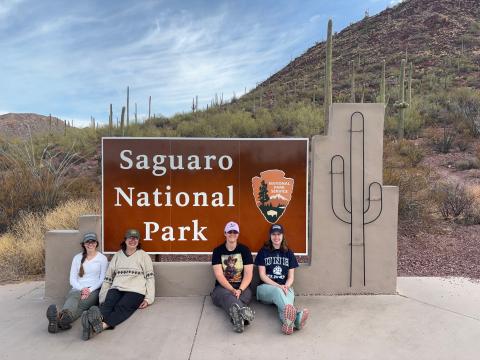
Anna at Saguaro National Park
1. What is your research about?
My research is focused on using Leave No Trace signage for soundscape management in national parks. Soundscapes are all the sounds people hear, including natural and human-made sounds. Natural soundscapes have many health and well-being benefits for people, and they also support wildlife. As outdoor recreation has soared in popularity since the COVID-19 pandemic, national parks have become more crowded, and therefore noisier than ever.
My research is a partnership between the National Park Service (NPS) and Leave No Trace (LNT), an organization focused on minimizing the environmental impacts of outdoor recreationists. We are interested in how effective LNT signage is at reducing human-made noise, such as people talking loudly and playing music out loud. This research will be used by the NPS to decide whether and where LNT signage could be implemented in national parks to quiet some of America's most unique landscapes.
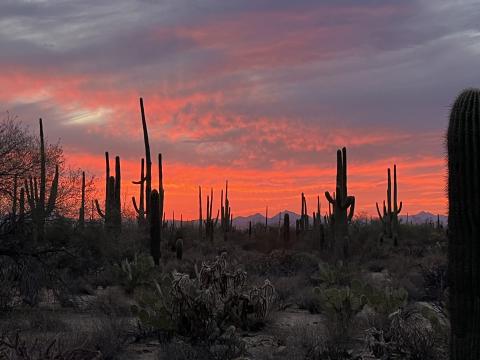
Sunset in Saguaro National Park
2. Where did you conduct your research?
I conducted this research in Saguaro National Park, which is split into two districts on the east and west side of Tucson, Arizona. Researchers from UNH and Kansas State University collaborated to complete fieldwork. We used several methods, including a face-to-face visitor survey, acoustic monitoring, and a mapping exercise in which visitors were asked where music, loud talking, and aircraft noise are acceptable or unacceptable in the park.
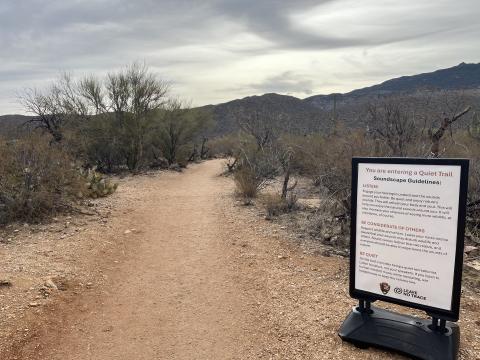
Leave No Trace signage in Saguaro National Park
3. What’s the coolest part of your research?
We collected data from a mapping exercise, which is called public participation Geographic Information System (GIS). This method is really cool because it captures lived experiences and personal insight from visitors actually using the park. For instance, there are places people said they enjoyed hearing loud talking, such as picnic areas, because it made them feel part of a community. On the other hand, there are places people said they didn't want to hear music playing because it is where they go for solitude. Outdoor recreation is very personal, and it is essential for us as social science researchers to capture the element of human experience in our data.
Another cool part of this project was that we got to stay in NPS housing in Saguaro National Park. It has always been my dream to do fieldwork in a national park, and it was amazing to be so close to hiking trails and views of iconic saguaro cacti. Almost every day after finishing our fieldwork, I got to explore a new part of the park. Also, we were in a great location to try some of the best Mexican food I've eaten.
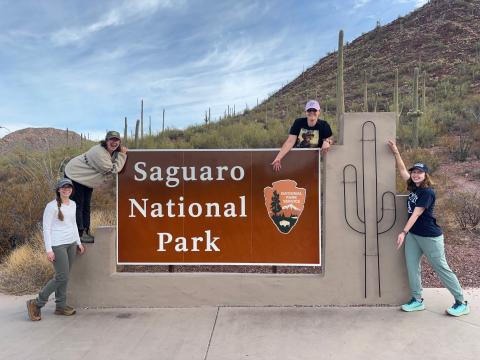
Anna at Saguaro National Park
4. What motivates you to do this research?
I am really interested in how sensory-rich experiences in the outdoors can shape a connection to nature. This is something I first noticed while thru-hiking the Appalachian Trail in 2022. A lot of my memories of thru-hiking are shaped by a sensory element — certain smells, sounds, and sights bring me back to the trail. Sensory-rich experiences are key to fostering a relationship with nature. A trail filled with the sounds of birdsong, running water, and wind blowing through the trees is much more likely to leave a lasting impression on someone than a trail next to a highway or an airport. Our research is aimed at protecting natural soundscapes in national parks.
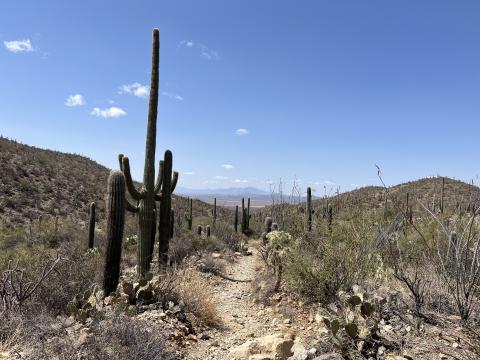
Cacti in Saguaro National Park
5. What made you decide to come to UNH for grad school?
I came to UNH because of the recreation management and policy program and the amazing professors in our department. My advisor, Lauren Ferguson, and I really clicked and I was interested in her research, so UNH was a great fit. I also love the Seacoast and being so close to the White Mountains!
6. What advice would you give to other students who are starting research?
Research is amazing! It is an ever-evolving process, and there are usually unexpected hurdles. Being patient and adaptable will help you stay grounded. Finding the right advisor is really important, too. I feel very lucky to work with Lauren, as she is super supportive and easy to talk to.
Research funding and collaboration: Leave No Trace, National Park Service, Lauren Ferguson (UNH), Brian Peterson (Kansas State University), and Kansas State University student and post-doctoral researchers
